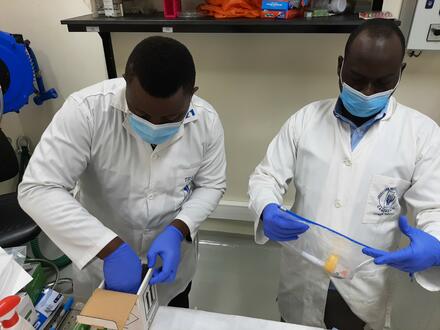RAIDER: Training Central African experts to improve field surveillance in remote areas
When you hear RAIDER, you may be thinking of Indiana Jones searching for the Lost Ark. In this instance however, we are speaking of RAIDER of the lost bark – something a little more relevant to our canine friends and our mission to eliminate rabies. For the GARC team and the rabies community, the RAIDER means saving more lives more effectively. The RAIDER, or the “Rapid In-Field Diagnosis and Epidemiology of Rabies toolkit, was developed by GARC to help professionals to detect, diagnose, and report rabies cases faster. The speed of diagnosis and reporting is crucial to saving both human and animal lives. If rabies cases are diagnosed and reported quickly, teams can go out and vaccinate in that area without delay, meaning that the cycle of rabies can be broken before anyone else is infected. In fact, the RAIDER toolkit takes rapid diagnosis to the maximum as it can be used to safely diagnostically screen and report suspect animals in the community, whether it is on the side of the road, in a field, or anywhere else a suspect animal is found – there is no need for any sophisticated equipment. The full process takes less than 1 hour, after which the preliminary result is reported. This means that an hour after a potential rabies case has been identified, a response team can be preparing to head out and vaccinate while the sample is still on its way to the laboratory for confirmatory testing!

We recently went to Cameroon as part of a regional diagnostic training workshop that was undertaken in collaboration with the UN FAO where the GARC team trained 15 rabies laboratory professionals from 5 Central African countries on the RAIDER toolkit. The participants underwent a series of lectures covering the theoretical knowledge, and then had the opportunity to do hands-on training of the entire RAIDER toolkit, starting with obtaining a rabies sample in the field with a safe, cheap, and effective method to the in-field diagnostic screening, reporting and sample shipment.
Most people will have experience using the COVID rapid test kits, where you test for COVID on the spot. The RAIDER toolkit uses a similar type of test for rabies, along with our free mobile phone app for immediate reporting. Just like the COVID rapid tests, the rabies rapid tests are not perfect. This means that the results need to be confirmed in the laboratory at a later time. By relying on a rapid test for rabies, the RAIDER protocol helps the user to prioritize samples so that only high priority samples are shipped immediately. This helps to cut down on shipment and sample transport costs, which are often a major limiting factor in rabies surveillance programs. However, the biggest benefit is that any positive result is reliable and that means we can stop rabies sooner by vaccinating in the area where the positive case was identified. This also means that countries that may have fewer laboratories or limited capacity are able to still have a strong rabies surveillance system in place, without the need to invest millions of dollars in building new laboratories and improving sample transport.

The workshop ran for the course of just 4 days, after which the expert representatives were proficient in the RAIDER toolkit. As testament to this, just one day after the workshop concluded, the toolkit was used, and a positive rabies sample was identified in a community. It is always so rewarding to see that the training that is done is implemented and helps countries to drive their rabies elimination efforts one step closer to our global goal of dog-rabies elimination!
Learn more about our RAIDER toolkit and supporting rabies surveillance tools and contact us to explore implementation in your own country.
You can also support our work by helping us train more experts and deliver the RAIDER in needy countries by donating to GARC. Just USD20 will help another rabies case be diagnosed.